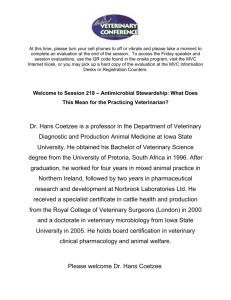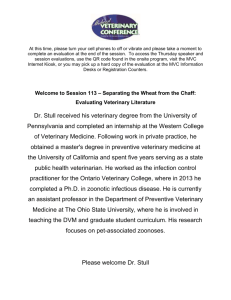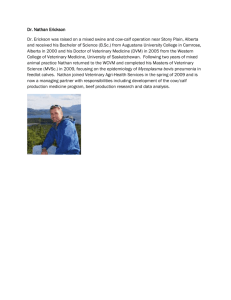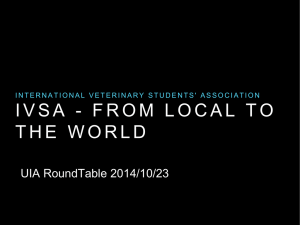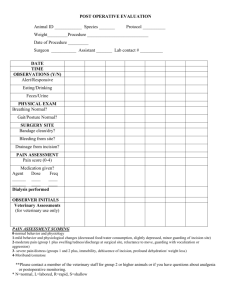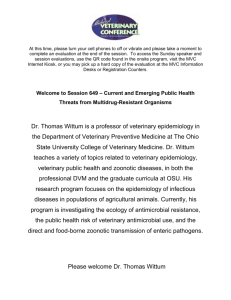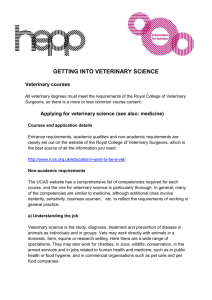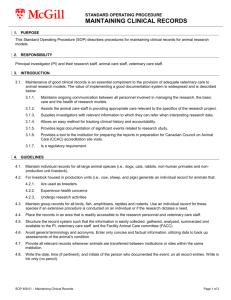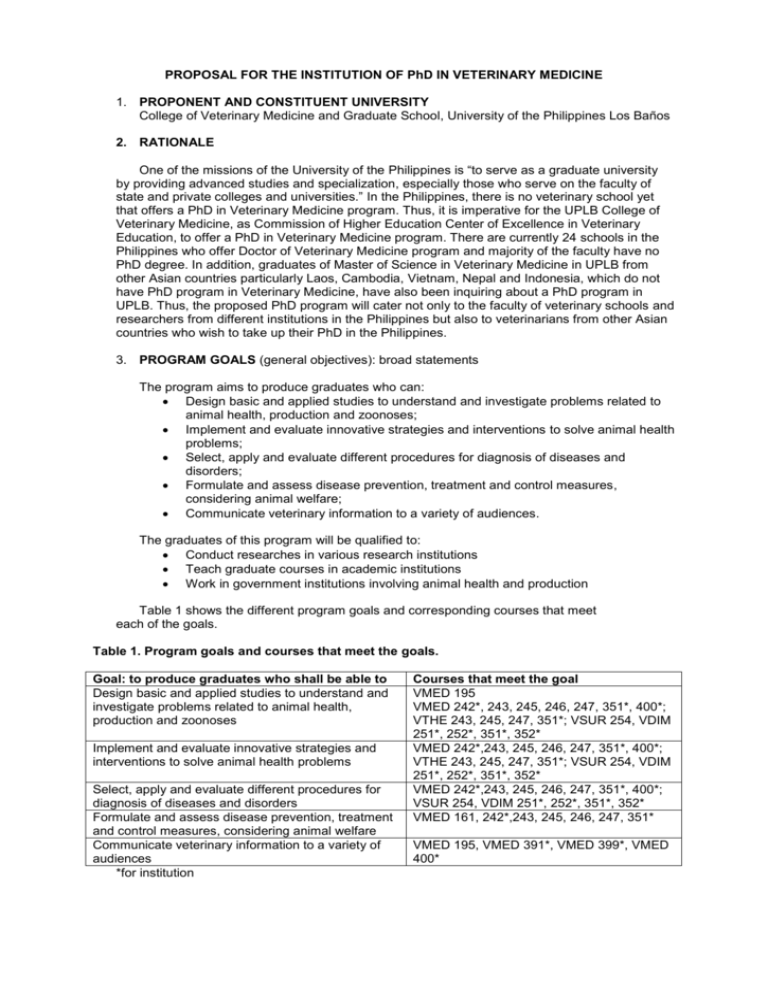
PROPOSAL FOR THE INSTITUTION OF PhD IN VETERINARY MEDICINE
1. PROPONENT AND CONSTITUENT UNIVERSITY
College of Veterinary Medicine and Graduate School, University of the Philippines Los Baños
2. RATIONALE
One of the missions of the University of the Philippines is “to serve as a graduate university
by providing advanced studies and specialization, especially those who serve on the faculty of
state and private colleges and universities.” In the Philippines, there is no veterinary school yet
that offers a PhD in Veterinary Medicine program. Thus, it is imperative for the UPLB College of
Veterinary Medicine, as Commission of Higher Education Center of Excellence in Veterinary
Education, to offer a PhD in Veterinary Medicine program. There are currently 24 schools in the
Philippines who offer Doctor of Veterinary Medicine program and majority of the faculty have no
PhD degree. In addition, graduates of Master of Science in Veterinary Medicine in UPLB from
other Asian countries particularly Laos, Cambodia, Vietnam, Nepal and Indonesia, which do not
have PhD program in Veterinary Medicine, have also been inquiring about a PhD program in
UPLB. Thus, the proposed PhD program will cater not only to the faculty of veterinary schools and
researchers from different institutions in the Philippines but also to veterinarians from other Asian
countries who wish to take up their PhD in the Philippines.
3. PROGRAM GOALS (general objectives): broad statements
The program aims to produce graduates who can:
Design basic and applied studies to understand and investigate problems related to
animal health, production and zoonoses;
Implement and evaluate innovative strategies and interventions to solve animal health
problems;
Select, apply and evaluate different procedures for diagnosis of diseases and
disorders;
Formulate and assess disease prevention, treatment and control measures,
considering animal welfare;
Communicate veterinary information to a variety of audiences.
The graduates of this program will be qualified to:
Conduct researches in various research institutions
Teach graduate courses in academic institutions
Work in government institutions involving animal health and production
Table 1 shows the different program goals and corresponding courses that meet
each of the goals.
Table 1. Program goals and courses that meet the goals.
Goal: to produce graduates who shall be able to
Design basic and applied studies to understand and
investigate problems related to animal health,
production and zoonoses
Implement and evaluate innovative strategies and
interventions to solve animal health problems
Select, apply and evaluate different procedures for
diagnosis of diseases and disorders
Formulate and assess disease prevention, treatment
and control measures, considering animal welfare
Communicate veterinary information to a variety of
audiences
*for institution
Courses that meet the goal
VMED 195
VMED 242*, 243, 245, 246, 247, 351*, 400*;
VTHE 243, 245, 247, 351*; VSUR 254, VDIM
251*, 252*, 351*, 352*
VMED 242*,243, 245, 246, 247, 351*, 400*;
VTHE 243, 245, 247, 351*; VSUR 254, VDIM
251*, 252*, 351*, 352*
VMED 242*,243, 245, 246, 247, 351*, 400*;
VSUR 254, VDIM 251*, 252*, 351*, 352*
VMED 161, 242*,243, 245, 246, 247, 351*
VMED 195, VMED 391*, VMED 399*, VMED
400*
4. PROGRAM STRUCTURE: Descriptive Information
4.1 Title: PhD in Veterinary Medicine (Specialization)
Specializations:
Veterinary Internal Medicine
Theriogenology
Diagnostic Imaging
4.2. No. of Semesters: 6
4.3. Total No. of Units: 41
4.3.1. Course Distribution of units
Course
Core
Major
Cognate
Special topics
Seminar
Dissertation
TOTAL
Core Courses
VMED 195
VMED 161*
Units
6
12
9
1
1
12
41
4.4. List of Courses in the Program (table)
Title
Research Methods in Veterinary Medicine
Animal Welfare
Major Courses
Title
VETERINARY INTERNAL MEDICINE
VMED 242*
Advanced Canine Medicine
VMED 243
Advanced Swine Medicine
VMED 244
Advanced Poultry Medicine
VMED 245
Advanced Equine Medicine
VMED 246
Advanced Ruminant Medicine
VMED 351*
Veterinary Acupuncture
VDIM 352*
Veterinary Echocardiography
THERIOGENOLOGY
VTHE 243
VTHE 245
VTHE 246
VTHE 247
VTHE 351*
VDIM 351*
Advanced Porcine Theriogenology
Advanced Equine Theriogenology
Advanced Bovine and Bubaline
Theriogenology
Advanced Ovine and Caprine
Theriogenology
Cryopreservation of Mammalian
Spermatozoa and Embryos
Veterinary Reproductive
Ultrasonography
VETERINARY DIAGNOSTIC IMAGING
VSUR 254
Veterinary Diagnostic Ultrasound
VDIM 251*
Veterinary Radiography
VDIM 252*
Veterinary Electrocardiography
VDIM 351*
Veterinary Reproductive
Ultrasonography
VDIM 352*
Veterinary Echocardiography
Units
3
3
Prerequisite/s
COI
VMED 151 or COI
Units
Prerequisite/s
3
3
3
3
3
3
3
VMED 152 or COI
VMED 154 or COI
VMED 154 or COI
VMED 153 or COI
VMED 153 or COI
VMED 151 or COI
COI
3
3
3
VTHE 251
VTHE 251
VTHE 251
2 (3)
VTHE 251
3
COI
3
VSUR 254
3
3
3
3
VSUR 154
VSUR 154
VSUR 154
VSUR 254
3
COI
Cognate Coursesx
Special topic
VMED 391
Seminar
Title
Special Topic in Veterinary Medicine
(Scientific Writing)
Title
1
Units
1
Prerequisite/s
None
Units
Prerequisite/s
VMED 399
Graduate Seminar in Veterinary Medicine
Dissertation
VMED 400
PhD Dissertation
*To be instituted.
xTo be chosen from other areas of specialization.
1
None
Units
12
None
4.5. Schedule of Courses
Course title
Course description
First year 1st semester
VMED 195
Research Methods in Veterinary Medicine
VMED 161
Animal Welfare
Major course 1
TOTAL
Units
Prerequisite
3
3
3
9
First year 2nd semester
Major course 2
Major course 3
Major course 4
TOTAL
3
3
3
9
Second year 1st semester
Cognate course 1
VMED 291
Special topic in Veterinary Medicine
VMED 400
PhD Dissertation
TOTAL
3
1
3
7
Second year 2nd semester
Cognate course 2
VMED 299
Graduate Seminar in Veterinary Medicine
VMED 400
PhD Dissertation
TOTAL
3
1
3
7
Third year 1st semester
Cognate course 3
VMED 400
PhD Dissertation
TOTAL
3
3
6
Third year 2nd semester
VMED 400
PhD Dissertation
TOTAL
3
3
4.6. List of Courses to be Instituted and their Prerequisites:
Course no.
VMED 161
VMED 242
VMED 351
VTHE 351
VDIM 251
VDIM 252
VDIM 351
VDIM 352
Course title
Animal Welfare
Advanced Canine Medicine
Veterinary Acupuncture
Cryopreservation of Mammalian Sperms and
Embryos
Veterinary Radiography
Veterinary Electrocardiography
Veterinary Reproductive Ultrasonography
Veterinary Echocardiography
2
Units
3
3
3
3
3
3
3
3
Prerequisite
VMED 151 or COI
VMED 152 or COI
VMED 151 or COI
VTHE 251 or COI
VSUR 154 or COI
VSUR 154 or COI
VSUR 254
VSUR 254
5. PROGRAM REQUIREMENTS
5.1. Admission, Retention, Transfer/Shifting
The admission, retention, transfer/shifting and academic requirements of the university for
existing programs shall be prescribed. In addition, applicants should be holders of an MS
degree in Veterinary Medicine or any related graduate degree from a recognized
institution.
5.2. Graduation
The requirements for graduation include the completion of all academic as well as nonacademic requirements such as submission of bound copies of PhD dissertation. The
student must pay the graduation fee and file a formal application to the Dean of the
Graduate School as a candidate for graduation. His graduation would also have to be
approved by the Graduate School Faculty, the University Council and the UP Board of
Regents.
6. RESOURCE REQUIREMENTS
6.1. Personnel
6.1.1. Within the College
Jovencio Hubert A. Abalos, MS (Veterinary Medicine)
Jezie A. Acorda, PhD (Large Animal Medicine and Surgery)
Amadeo A. Alcantar, MS (Swine Medicine)
Loinda R. Baldrias, PhD (Microbiology)
Francis Andrew Eugene M. Bernardo (Poultry Medicine)
Bella C. Cruzana, PhD (Microscopic Anatomy)
Joseph F. dela Cruz, MS (Animal Science)
Ma. Catalina T. de Luna, MAgric (Molecular Biology)
Billy P. Divina, MSc (Molecular Helminthology)
Rio John T. Ducusin, PhD (Large Animal Medicine and Surgery)
Salcedo L. Eduardo, PhD (Veterinary Parasitology)
Ma. Amelita C. Estacio, DAgrSc (Neurobiology)
Marianne Leila S. Flores, MHA (Hospital Administration)
Karlo Romano B. Gicana, MS (Veterinary Medicine)
Ceferino P. Maala, PhD (Gross Anatomy)
Benjamin Reuel G. Marte, MS (Clinical Pathology)
Joseph S. Masangkay, DAgrSc (Laboratory Animal Genetics)
Veronica A. Matawaran, MS (Veterinary Pathology)
Helen A. Molina, MVSt (Veterinary Pathology)
Joseph P. Olarve, MS (Animal Science)
Mildred A. Padilla, DrPH (Public Health)
Michelle Grace V. Paraso, PhD (Environmental Science)
Hope G. Rovira, PhD (Microbiology and Immunology)
Romeo E. Sanchez, PhD (Veterinary Virology)
Teodulo M. Topacio, PhD (Veterinary Microbiology)
Eduardo B. Torres, PhD (Theriogenology)
Conrado A. Valdez, PhD (Theriogenology)
6.1.2. Within Other UPLB Institutions:
Jose Arceo N. Bautista, PhD (Theriogenology)
Antonio A. Rayos, PhD (Theriogenology)
Consortia Reaño, PhD (Statistics)
6.2. Facilities
The facilities of the College of Veterinary Medicine shall be used in the
implementation of the program. The College has an experimental animal farm, Veterinary
Teaching Hospital, research laboratories and equipment from the different departments
and a library, which can be used for the program.
6.3. Facilities and Budget Requirements
Course no.
Course title
Supplies
and
3
Budget requirements
Equipment
First
and
year
Succeeding
years
VMED 161
VMED 242
VMED 351
VTHE 351
VDIM 251
VDIM 252
VDIM 351
VDIM 352
Animal Welfare
Advanced Canine Medicine
Veterinary Acupuncture
Cryopreservation of
Mammalian sperms and
embryos
Veterinary Radiography
Veterinary
Electrocardiography
Veterinary Reproductive
Ultrasonography
Veterinary Echocardiography
TOTAL
materials
10,000
10,000
10,000
10,000
laboratory
20,000
20,000
10,000
30,000
30,000
10,000
5,000
10,000
10,000
5,000
10,000
10,000
50,000
50,000
60,000
60,000
10,000
10,000
10,000
50,000
60,000
10,000
10,000
50,000
60,000
10,000
6.4. Relations and Linkages to Other Programs
6.4.1. Offered by the Unit: None
6.4.2. Offered by Other Units: None
7. EMPLOYMENT AND ENROLMENT PROJECTIONS
7.1. Projected Employment of Graduates
7.1.1. Work in international organizations, various government agencies that are
involved in disease control, environmental health and food safety and in research and
diagnostic laboratories;
7.2.2. Teach and perform research in veterinary and other schools; and
7.2.3. Engage in specialized veterinary practice
7.2. Projected Enrollment
Based on inquiries from faculty members of 24 veterinary schools in the country and our
MS(VetMed) graduates from ASEAN countries, 5-10 students per year are expected to enroll.
8. PROGRAM ADMINISTRATION
The program will be administered by the UPLB Graduate School through the College of
Veterinary Medicine.
4
PROPOSAL FOR THE INSTITUTION OF VMED 242
ADVANCED CANINE MEDICINE
I. IDENTIFYING AND DESCRIPTIVE INFORMATION
A. Catalogue Course Description
1. Course number:
VMED 242
2. Course title:
Advanced Canine Medicine
3. Course description:
Advanced techniques in diagnosis, treatment, prevention and control
of diseases and disorders of dogs
4. Prerequisite:
VMED 152 or COI
5. Course credit:
3 units
6. Number of hours:
5 hours a week (2 class, 3 lab)
7. Semesters offered:
2nd semester
8. Course goal:
For the student to be knowledgeable of advances in canine medicine
and use these advanced techniques in the management of diseases
and disorders of dogs.
B. Rationale
The rapidly increasing practice and business of veterinary clinics in the country is a clear
testament of the Filipino’s increasing awareness of the importance of veterinary attention to their
pets and their willingness to spend for such service. About 80% of patients brought to local
veterinary clinics are canines. Students must be made aware of emerging canine medical
problems and be updated on known ones in order to address the demand of increasingly
knowledgeable clientele. In addition, advances in diagnostic and therapeutic techniques, such as,
but not limited to skin allergy tests, Tru-cut needle or punch biopsy, contrast radiography,
electrotherapy, echocardiography, electrocardiography, and endoscopy for canine diseases and
disorders have made canine practice highly complex. Thus, this course aims to equip students
with the necessary knowledge and skills for modern small animal practice, including control and
prevention of canine diseases and disorders.
C. Course Outline
1. Specific Course Objectives: At the end of the course, the student should be able to:
a. Differentiate various advanced techniques for diagnosis and treatment of canine diseases
and disorders.
b. Apply advanced and alternative diagnostic techniques in canine diseases and disorders;
c. Institute appropriate advanced therapeutic regimen for canine diseases and disorders;
d. Integrate advanced and alternative approaches in the design of comprehensive health
program for canine patients.
2. Course Content:
3.
Lecture Topics
1. Overview of Canine Medicine
2. Alternative diagnostic procedures
2.1 Iridology
2.2. Ayurveda Philosophy
2.3. Kinesiology
Traditional Chinese diagnostic techniques
3. Applied Imaging Procedures
3.1 Electrocardiography
3.2 Echocardiography
3.3 Endoscopy
3.4 Abdominal Ultrasonography
3.5 Contrast Radiography
4. Nutraceuticals
4.1.Role of dietary components and their interactions with other environmental
factors
4.2. Dietary components for healthy dog
5. Emergency and Critical Care Medicine
5.1. Head Trauma
5.2. Cardiopulmonary Emergency
5.2. Monitoring of critical care patients
5.3. Fluid therapy of critical care patients
5
No. of hours
1
2
10
2
4
6. Dermatology, Allergology and Endocrinology
6.1. Allergy Testing
6.2 Skin and Nail Biopsy
6.3 Advanced Diagnostic Cytology
6.4 Molecular Endocrinology
7. Dentistry
7.1. Root Canal Therapy
7.2. Orthodontics
7.3. Dental Prosthetics and Implants
8. Oncology
8.1. Organ Biopsy and Histopathology
8.2. Cancer Treatment
8.3. Selected neoplasm in dogs
9. Complementary and alternative therapeutic procedures
9.1. Physiotherapy
9.1. Herbal therapy
9.3. Acupuncture therapy
10. Integration of conventional, alternative and advanced medical procedures
Examination
Total
Exercise No.
1
2
3
4
5
6
7
8
9
10
11
12
13
14
Laboratory topic
Overview of Techniques in Canine Medicine
Alternative Diagnostic Techniques
Emergency and Critical Care Medicine
Electrocardiography
Echocardiography
Endoscopy
Abdominal Ultrasonography
Contrast Radiography
Allergy testing and NAET
Special Dental Procedures
Biopsy, Cytology and Histopathology
Electrotherapy
Acupuncture Stimulation
Case presentation and analysis
Integrated comprehensive health program
Examination
Total
2
2
3
3
1
2
32
No. of
meetings
1
1
1
1
1
1
1
1
1
1
1
1
1
1
1
1
16/48
3. Course Requirements:
1. Examinations and quizzes
2. Case reports and oral presentations
3. Student journal/ portfolio
4. References
Books
Ettinger SJ and EC Feldman. 2000. Textbook of Veterinary Internal Medicine. Vol. 1. 5 th
ed. Philadelphi: WB Saunders Co.
Ettinger SJ and EC Feldman. 2000. Textbook of Veterinary Internal Medicine. Vol. 2. 5 th
ed. Philadelphi: WB Saunders Co.
Bonagura JD and DC Twedt. 2009. Kirk’s Current Veterinary Therapy XIV.
Braund KG. 1994. Clinical Syndrome in Veterinary Neurology. 2nd ed. St. Louis, MO:
Mosby.
Carmichael DT. 2003. Recent advances in small animal dentistry.
Carter GR and PA Payne. 2006. A concise guide to infectious and parasitic diseases of
dogs and cats.
Concannon PW, GCW England, J Verstegen and C Linde-Forsberg. 2006. Recent
advances in small animal reproduction.
6
Ford RB and EM Mazzaferro. 2006. Kirk and Bistner’s Handbook of Veterinary
Procedures and Emergency Treatment. 8th ed. St. Louis, MO: Elsevier, Inc.
Gough A. 2007. Differential Diagnosis in Small Animal Medicine. Oxford, Blackwell
Publishing Ltd.
Gough A and Thomas A. 2004. Breed Predispositions to Disease in Dogs and Cats.
Oxford, Blackwell Publishing Ltd.
Hall E, K Murphy and P Darke. 2003. Notes on Canine Internal Medicine. Oxford, UK:
Blackwell Publishing Inc.
Medleau L and Hnilica KA. 2001. Small Animal Dermatology: A Color Atlas and
Therapeutic Guide. 1st ed. Philadelphia: WB Saunders Co.
Morgan RV. 1992. Handbook of Small Animal Practice. 2 nd ed. Churchill Livingstone Inc.
Nelson RW and CG Couto. 1992. Essentials of Small Animal Internal Medicine. St. Louis,
MO: Mosby Year Book.
Newton CD and DM Nunamaker (eds). Textbook of small animal orthopaedics. Ithaca,
NY: International Veterinary Information Service.
Thrall MA, DC Baker, RW Campbell, D DeNicola, MJ Fettman, ED Lassen, A Rebar and
G Weiser. 2004. Veterinary Hematology and Clinical Chemistry. Baltimore, MD:
Lippincott Williams and Wilkins.
Tilley LP and FWK Smith (eds.) 2007. Blackwell’s Five-Minute Veterinary Consult
(Canine and Feline). 4th ed, Ames, IA: Blackwell Publishing Professional.
Vite CH. 2006. Braund’s Clinical neurology in small animal – localization, diagnosis and
treatment.
Journals
American Journal of Veterinary Research
Australian Veterinary Journal
In Practice
Journal of American Veterinary Medical Association
Journal of American Animal Hospital Association
Journal of Veterinary Internal Medicine
Journal of Veterinary Medical Science
Modern Veterinary Practice
Philippine Journal of Veterinary Medicine
Veterinary Dermatology
Veterinary Focus
Veterinary Forum
Veterinary Medicine
Veterinary Record
2. ANALYTICAL INFORMATION
A. Instructional model
1. Teaching method:
Type of session
Lecture (relay teaching)
Laboratory
Preferred
class size
5-10
5-10
Staff required
3
1
No. of hours per
week
2
3
No. of credits
2. Mode of Delivery: lecture, demonstration, case analysis, laboratory exercises
B. Special additional resources and personnel required
1. Special facilities: existing
2. Library and other learning resources: existing
3. Special staff competencies required
4. Names of staff qualified to teach the course:
From the College of Veterinary Medicine
Jovencio Hubert A. Abalos, MS Veterinary Medicine
Jezie A. Acorda, PhD Large Animal Surgery
Francis Andrew Eugene M. Bernardo, MS Veterinary Medicine
Rio John T. Ducusin, PhD Ruminant Medicine
Marianne Leila S. Flores, MHA Hospital Administration
Karlo Romano B. Gicana, MS Veterinary Medicine
7
2
1
Jesalyn L. Constante, MS Veterinary Medicine
Veronica A. Matawaran, MS Clinical Pathology
Helen A. Molina, MVSc Pathology
Eduardo B. Torres, PhD Theriogenology
C. Relation to other courses
1. Offered by the Department
a. Course replaced by the course: None
b. Prerequisite course: VMED 152
c. Course for which this course is a prerequisite: None
d. Course containing similar content:
VMED 152 (20%); VSUR 154 (5%), VMED 151 (10%); VPTH 123 (10%)
2. Offered by other Departments: None
D. Size and source of enrolment
1. Department majors: 2-5
2. Majors in other departments, curricula or college: 2-5
3. Anticipated enrolment in first and second years of offering: 16-20
E. Estimated funds required by addition of this course
1. Salaries: None
2. Supplies and materials:
Books and journals ( Php 50,000)
3. Equipment: Existing
F. Laboratory fee: PhP 3,500
8
PROPOSAL FOR THE INSTITUTION OF VMED 351
VETERINARY ACUPUNCTURE
I. IDENTIFYING AND DESCRIPTIVE INFORMATION
A. Course Catalogue Description
1. Course number:
VMED 351
2. Course Title:
Veterinary Acupuncture
3. Course Description: Principles and applications of acupuncture in animals
4. Prerequisite:
VMED 151 or COI
5. Semesters offered: 2nd semester
5. Course credit:
3 units
6. Number of hours:
5 hours a week (2 class, 3 lab)
7. Course goal:
For the student to apply acupuncture in the management of diseases
and disorders of animals.
B. Rationale
At present, there is an increasing demand for more natural therapies with less side effects. With
the proliferation of various complementary and alternative therapies for animals, veterinarians
who have been trained only in conventional therapies are faced with the prospect of limited
resources to treat various diseases and disorders. Acupuncture, which has been accepted as a
therapeutic modality in animals in many countries throughout the world, including the United
States, Belgium, Finland, Australia, Japan, South Korea and China, has found limited application
in the Philippines primarily due to lack of training of veterinarians. This course will hope to provide
practicing veterinarians with a natural therapeutic procedure for treatment of diseases and
disorders which are not amenable to conventional therapies.
C. Course Outline
1. Specific Course Objectives: Upon completion of the course, the student should be able to:
a. Discuss the principles of veterinary acupuncture;
b. Identify acupuncture points and meridians in domestic animals;
c. Perform different methods of acupuncture stimulation;
d. Apply acupuncture for producing analgesia for surgical procedures;
e. Diagnose diseases and disorders using acupuncture principles
f. Formulate treatment protocol using acupuncture for treatment of diseases and disorders.
2. Course Content:
Lecture Topics
1. Overview of veterinary acupuncture
1.1. Definitions
1.2. Status
1.3. Problems and issues
1. Principles of acupuncture
2.1. Introduction to Chinese Traditional Medicine
2.2. Mechanisms of acupuncture
2.3 Acupuncture points and meridians
3. Acupuncture stimulation
3.1. Equipments, instruments and accessories
3.2. Methods of stimulation
4. Acupuncture analgesia
4.1. Characteristics
4.2. Point selection in small animals
4.3. Point selection in large animals
5. Acupuncture diagnosis
5.1. Physical examination
5.2. Alarm and association points
6. Acupuncture therapy in small animals
6.1. Musculo-skeletal disorders
6.2. Reproductive disorders
6.3 Digestive disorders
6.4 Circulatory disorders
6.5 Respiratory disorders
6.6 Other disorders
9
No. of hours
2
6
2
2
2
8
7. Acupuncture therapy in large animals
7.1. Musculo-skeletal disorders
7.2. Reproductive disorders
7.3 Digestive disorders
7.4 Circulatory disorders
7.5 Respiratory disorders
7.6 Other disorders
Examinations
TOTAL
8
2
32
Laboratory:
Exercise
No.
1
2
3
4
5
6
7
8
9
10
11
Title
Equipments and instruments for acupuncture
Identification of acupuncture points in dog
Identification of acupuncture points in horse
Identification of acupuncture points in cattle
Different methods of acupuncture stimulation
Acupuncture analgesia in sheep
Acupuncture stimulation in dog and cat
Acupuncture stimulation in horse and cattle
Acupuncture diagnosis of selected cases
Formulation of acupuncture therapy in small animals
Formulation of acupuncture therapy in large animals
Examinations
TOTAL
No. of
Meetings
1
1
1
1
1
1
1
1
2
2
2
2
16
3. Course requirements:
Examinations, Quizzes, Exercises and Case Report
4. References
Books
Chuan Y. 1992. Traditional Chinese Veterinary Acupuncture and Moxibustion. Beijing:
China Agricultural Press.
Food and Agricultural Organization. 1990. Handbook on Chinese Veterinary Acupuncture
and Moxibustion. Bangkok: FAO/APHCA Publication.
Goldstein RS (ed.). 2008. Integrating Complementary Medicine into Veterinary Practice.
Ames, Iowa: Wiley-Blackwell.
Ramey DW and Rollin BE. 2003. Complementary and Alternative Veterinary Medicine
Considered. Ames, Iowa: Iowa State Press.
Schwartz C. 1996. Four Paws Five Directions. A Guide to Chinese Medicine for Cats and
Dogs. Berkeley: Celestial Arts Publishing.
Schoen AM. 1994. Veterinary Acupuncture. Ancient Art to Modern Medicine. St. Louis:
American Veterinary Publications, Inc.
Schoen AM and Wynn SG. 1998. Complementary and Alternative Veterinary Medicine:
Principles and Practice. St. Louis: Mosby.
Xinnong C. 2004. Chinese Acupuncture and Moxibustion (revised edition). Beijing:
Foreign Languages Press.
Journals
Acupuncture and Electrotherapy Research International Journal
Acupuncture in Medicine
Acupuncture Research Quarterly (Taiwan)
American Journal of Acupuncture
American Journal of Veterinary Research
Australian Veterinary Journal
Chinese Acupuncture and Moxibustion
Guidepoints: Acupuncture in Recovery
Journal of the American Veterinary Medical Association
Journal of the Japan Society of Acupuncture and Moxibustion
Journal of Veterinary Internal Medicine
10
Philippine Journal of Veterinary Medicine
Scandinavian Journal of Acupuncture and Electrotherapy
The American Academy of Medical Acupuncture
The Australian Journal of Acupuncture
The Japanese Journal of Veterinary Research
The Japanese Journal of Veterinary Science
Traditional Acupuncture Journal
World Journal of Acupuncture and Moxibustion
II. ANALYTICAL INFORMATION
A. Instructional Model
1. Teaching Method:
Type of session
Preferred
class size
Lecture (relay)
5-10
Laboratory
5-10
Staff required
3
1
No. of hours
per week
2
3
No. of credits
2
1
2. Mode of Delivery: Lecture and Laboratory
B. Special or Additional Resources and Personnel Requirements
1. Special Facilities: Existing
2. Library and other learning resources: Existing
3. Special staff competencies required: None
4. Names of staff qualified to teach part(s) of the course:
From the College of Veterinary Medicine
Jezie A. Acorda, PhD Large Animal Surgery
Jovencio Hubert A. Abalos, MS Veterinary Medicine
Rio John T. Ducusin, PhD Ruminant Medicine
Marianne Leila S. Flores, MHA Hospital Administration
Karlo B. Gicana, MS Veterinary Medicine
Eduardo B. Torres, PhD Theriogenology
Conrado A. Valdez, PhD Theriogenology
C. Relation to Other Courses:
1. Offered by the Department
a. Course replaced by this course: None
b. Prerequisite course: VMED 151
c. Course for which this course is a prerequisite: None
d. Course containing similar content: VMED 151 (5%), VMED 261 (15%)
2. Offered by Other Departments: None
D. Size and Source of Enrollment
1. Department majors: 3-5
2. Majors in other departments, curricula, or college: 3-5
3. Anticipated enrollment in first and second years of offering: 12-20
E. Estimated Funds Required by the Institution of this Course:
1. Salaries: None
2. Supplies and materials: Php10,000
Books and journals (PHP 10,000)
3. Equipments: Existing
F. Proposed Laboratory fee: Php: 3,800
Breakdown of laboratory fees (for 5-6 students):
Item
Acupuncture needles
Acupuncture needle applicators
Acupuncture patches, beads, magnets, etc.
Cupping kit
Moxa rolls, stands, etc.
“Rental fee” or depreciation cost of the electrostimulator machine
Miscellaneous supplies (alcohol, cotton, towels, vinegar, matches, soap,
11
Cost (PhP)
8,000
1,000
2,000
2,000
1,000
2,000
3,000
brush, batteries, etc.)
19,000
PhP 19,000/5 students ;PhP 3,800
12
PROPOSAL FOR THE INSTITUTION OF VTHE 351
CRYOPRESERVATION OF MAMMALIAN SPERMATOZOA AND EMBRYOS
I. IDENTIFYING AND DESCRIPTIVE INFORMATION
A. Catalogue Course Description
1. Department Number: VTHE 351
2. Descriptive Title:
Cryopreservation of Mamalian Spermatozoa and Embryos
3. Course Description:
Principles, application and techniques of cryopreservation of
mammalian spermatozoa and embryos
4. Prerequisite:
COI
5. Semester Offered:
1st and 2nd semester
6. Credit:
3 units
7. Number of hours:
5 hours (2 class, 3 lab)
8. Course goal:
For the student to the apply the technique of cryopreservation in
mammalian spermatozoa and embryos
B. Rationale
Cryopreservation is a valuable technology for the long-term storage of spermatozoa and embryos
of animals of superior genetic merit. Moreover, cryopreservation has allowed the use of valuable
germplasm anytime when needed by the farmer, and therefore has a great impact on animal
breeding and related reproductive biotechnologies such as artificial insemination, embryo transfer,
in vitro fertilization, embryo micromanipulation, gene transfer and cloning contributing immensely
to improved animal. The course aims to fully orient and equip veterinary students with to
necessary knowledge and skills on the principles, applications and different techniques of
cryopreservation of animal spermatozoa and embryos.
C. Course Outline
1. Specific Course Objectives: Upon completion of the course, the student should be able to:
a. Describe the basic principles and applications of cryopreservation
b. Describe the different techniques of cryopreservation
c. Assess and interpret results of viability evaluation of cryopreserved and spermatozoa and
embryos
2. Course Content:
Lecture Topics
1. Introduction to cryopreservation
2. Principles of cryobiology
2.1.
2.2.
2.3
3. Applications of cryopreservation
3.1.
3.2.
3.3
4. Equipments and guidelines for cryopreservation of spermatozoa
4.1.
4.2.
4.3
5. Equipments and guidelines for cryopreservation of embryos
5.1.
5.2.
5.3
6. Cryopreservation techniques for spermatozoa
6.1.
6.2.
6.3
7. Cryopreservation techniques for embryos
7.1.
7.2.
7.3
8. Viability evaluation methods for cryopreserved spermatozoa
13
No. of hours
1
2
1
2
2
5
5
5
8.1.
8.2.
8.3
9. Viability evaluation methods for cryopreserved embryos
9.1.
9.2.
9.3
10. Special cryopreservation techniques
10.1.
10.2.
10.3
Examinations
TOTAL
5
2
2
32
Laboratory:
Exercise
No.
1
2
3
4
5
6
7
8
9
Title
Equipments for cryopreservation of spermatozoa
Equipments for cryopreservation of embryos
Guidelines for cryopreservation of spermatozoa
Guidelines for cryopreservation of embryos
Cryopreservation of spermatozoa of laboratory and
domestic animals
Cryopreservation of spermatozoa of laboratory and
domestic animals
Viability evaluation techniques for cryopreserved
spermatozoa
Viability evaluation techniques for cryopreserved embryos
Special cryopreservation techniques
Examinations
TOTAL
No. of
Meetings
1
1
1
1
3
3
2
2
1
1
16
3. Course requirements:
Examinations, Quizzes, Exercises and Case Report
4. References
Books
Arthur GH, Noakes OE, Pearson H and ParkinsonTJ. 1996. Veterinary Reproduction and
Obstetrics. 7th ed. Philadelphia: WB Saunders Co.
Bearden HJ, Fuquay JW and Willard ST. 2004. Applied Animal Reproduction. New
Jersey: Pearson Prentic Hall.
Hafez ESE and Hafez B. 2000. Reproduction in Farm Animals. 7th ed. Philadelphia:
Lippincott Williams and Wilkins.
Herman HA, Mitchell JR and Doak GA. 1994. The Artificial Insemination and Embryo
Transfer of Dairy and Beef Cattle, A Handbook and Laboratory Manual. 8th ed.
Danville, Illinois:Interstate Publishers, Inc.
Miyamoto H and Manabe N. 1998. Reproductive Biology Update. Kyoto, Japan:
Nakamishi Printing Co., Ltd.
Morrow DA. 1980. Current Therapy in Theriogenology, Philadelphia: WB Saunders Co.
Morrow DA. 1986. Current Therapy in Theriogenology 2, Philadelphia: WB Saunders Co.
Roberts SJ. 1986. Veterinary Obstetrics and Genital Diseases (Theriogenology). 3rd ed.
Woodstock, Vermont.
Ruppel CL and Hill HJ. 1980. Study Course in Animal Reproduction. Arvada, Colorado:
World Wide Enterprises, Inc.
The Freezing of Mammalian Embryos. 1977. Ciba Foundation Symposium 52. North
Holland: Elsevier Excerpta Medica
Journals
American Journal of Veterinary Research
Journal of Veterinary Science
14
Philippine Journal of Veterinary and Animal Sciences
Philippine Journal of Veterinary Medicine
The Japanese Journal of Veterinary Research
The Journal of Veterinary Medical Science
Theriogenology
Veterinary Record
II. ANALYTICAL INFORMATION
A. Instructional Model
1. Teaching Method:
Type of session
Preferred
class size
Lecture (relay)
5-10
Laboratory
5-10
Staff required
3
1
No. of hours
per week
2
3
No. of credits
2
1
2. Mode of Delivery: Lecture and Laboratory
B. Special or Additional Resources and Personnel Requirements
1. Special Facilities: Existing
2. Library and other learning resources: Existing
3. Special staff competencies required: None
4. Names of staff qualified to teach part(s) of the course:
From the College of Veterinary Medicine
Jovencio Hubert A. Abalos, DVM, MS
Rio John T. Ducusin, DVM, MAgr, PhD
Eduardo B. Torres, DVM, MS, PhD
Conrado A. Valdez, DVM, MVetMedSc, PhD
From the Dairy Training and Research Institute, ADSC, CA
Jose Arceo N. Bautista, DVM, PhD
Antonio A. Rayos, DVM,MS, PhD
b) New staff requirements: None
C. Relation to other courses:
1. Offered by the Department
a. Course replaced by this course: None
b. Prerequisite course: COI
c. Course for which this course is a prerequisite: None
d. Course containing similar content: None
2. Offered by other Department: None
D. Size and source of enrolment
1. Department majors: 5
2. Majors in other department, curricula or college: 5
E. Estimated funds required by addition of this course
1. Salaries: Existing
2. Supplies and Materials
French straws PhP 5,000.00
Cryoprotectants
10,000.00
Liquid Nitrogen
15.000.00
Books and Journals
10,000.00
3. Equipment: Existing
Liquid Nitrogen tanks – 2 units
Freezing machines (existing at Philippine Carabao Center and Dairy Training and
Research Institute, ADSC,CA)
F. Proposed Laboratory fee: Php: 3,800
Breakdown of laboratory fees (for 5-6 students):
Item
Quantity & Unit cost
15
Cost (PhP)
Total
PhP 19,000/5 students ;PhP 3,800
16
19,000
PROPOSAL FOR THE INSTITUTION OF VDIM 351
VETERINARY REPRODUCTIVE ULTRASONOGRAPHY
I. IDENTIFYING AND DESCRIPTIVE INFORMATION
A. Course Catalogue Description
1. Course number:
VDIM 351
2. Course Title:
Veterinary Reproductive Ultrasonography
3. Course Description: Application of diagnostic ultrasound for reproduction in animals
4. Prerequisite:
VSUR 154 or COI
5. Semesters offered: 2nd semester
5. Course credit:
3 units
6. Number of hours:
5 hours a week (2 class, 3 lab)
7. Course goal:
For the student to apply ultrasonography in the diagnosis of
pregnancy and reproductive diseases and disorders of animals.
B. Rationale
In the Philippines, examination of animals for pregnancy and reproductive disorders has
traditionally relied on rectal palpation in large animals and abdominal examination and
radiography in small animals, supplemented with laboratory examinations. However, in other
countries, diagnostic ultrasound or ultrasonography has already been widely used as a tool for
examination of pregnancy and diagnosis of diseases and disorders of the reproductive organs.
With the popularity of low-cost ultrasound equipment, veterinarians are now becoming
increasingly aware of the benefits of ultrasonography in disease diagnosis. In the Philippines,
however, very few veterinarians are equipped with both the knowledge and skills in pregnancy
diagnosis and examination of reproductive disorders using ultrasonography. The course aims to
equip the students on the applications of ultrasonography for early detection of pregnancy and
evaluation of diseases and disorders of reproductive organs in animals.
C. Course Outline
1. Specific Course Objectives: Upon completion of the course, the student should be able to:
g. Discuss the ultrasound features of reproductive organs in animals;
h. Apply ultrasonography for pregnancy diagnosis in animals; and
i. Interpret ultrasonograms for diagnosis of reproductive diseases and disorders of animals.
2. Course Content:
Lecture Topics
2. Overview of diagnostic ultrasonography
2.1. Principles of ultrasonography
2.2. Comparison between ultrasonography and radiography
11. Ultrasonography in the horse
2.1. Female reproductive organs
2.2. Fetus
2.3 Male reproductive organs
2.4 Reproductive disorders
12. Ultrasonography in cattle
2.1. Female reproductive organs
2.2. Fetus
2.3 Male reproductive organs
2.4 Reproductive disorders
13. Ultrasonography in buffaloes
2.1. Female reproductive organs
2.2. Fetus
2.3 Male reproductive organs
2.4 Reproductive disorders
14. Ultrasonography in sheep and goats
2.1. Female reproductive organs
2.2. Fetus
2.3 Male reproductive organs
2.4 Reproductive disorders
15. Ultrasonography in dogs and cats
2.1. Female reproductive organs
17
No. of hours
2
2
2
2
2
2
2.2. Fetus
2.3 Male reproductive organs
2.4 Reproductive disorders
16. Ultrasonography in pigs
2.1. Female reproductive organs
2.2. Fetus
2.3 Male reproductive organs
2.4 Reproductive disorders
17. Ultrasonography in exotic and laboratory animals
2.1. Female reproductive organs
2.2. Fetus
2.3 Male reproductive organs
2.4 Reproductive disorders
Examinations
2
2
TOTAL
2
32
Laboratory:
Exercise No.
1
2
3
4
5
6
7
8
9
10
10
Title
Equipment for ultrasonography
Guidelines for ultrasonography of the
reproductive tract
Ultrasonography of the equine reproductive tract
Ultrasonography of the bovine reproductive tract
Ultrasonography of the bubaline reproductive
tract
Ultrasonography of the ovine reproductive tract
Ultrasonography of the caprine reproductive tract
Ultrasonography of the porcine reproductive tract
Ultrasonography of the canine reproductive tract
Ultrasonography of the feline reproductive tract
Ultrasonography of the reproductive tract in
laboratory animals
Examination
No. of Meetings
1
1
2
2
2
1
1
1
2
1
1
1
16
TOTAL
5. Course requirements:
Examinations, Quizzes, Exercises and Case Report
6. References
Books
Barr F. 1990. Diagnostic ultrasound in the dog and cat. London: Blackwell Scientific
Publications.
Bushong SC and Archer BR. 1991. Diagnostic Ultrasound: Physics, Biology and
Instrumentation. St. Louis: Mosby-Year Book, Inc.
England G. 2005. Fertility and Obstetrics in the Horse (3rd ed). Blackwell Publishing.
Farrow CS. 2003. Veterinary Diagnostic Imaging in the Dog and Cat. St. Louis, Missouri:
Mosby, Inc.
Fleischer AC and James AE. 1989. Diagnostic Sonography: Principles and Clinical
Applications. Philadelphia: W.B. Saunders Co.
Kähn W. 2004. Veterinary Reproductive Ultrasonography. Hannover: Schlütersche
Verlagsgesellschaft mbH & Co.
Kealy JK and McAllister H. 2000. Diagnostic Radiology and Ultrasonography of the Dog
and Cat, 3rd ed. Philadelphia: W.B. Saunders Company.
Mattoon JS. 1995. Veterinary Diagnostic Ultrasound. Philadelphia: W. B. Saunders Co.
Lamb CR. 1994. Diagnostic Imaging of the Dog and Cat. England: Mosby-Year Book
Europe Limited.
Lutz H and Meudt R. 1984. Manual of Ultrasound. New York: Springer-Verlag.
Kustritz MVR. 2003. Small Animal Theriogenology. St. Louis, Missouri: Elsevier Science.
18
Mannion P. 2006. Diagnostic Ultrasound in Small Animal Practice. Blackwell Publishing
Company.
Morel MCGD. 2003. Equine Reproductive Physiology, Breeding and Stud Management
(2nd ed). Wallingford, CABI Publishing.
Noakes DE, Parkinson TJ and England GCW (eds.). 2011. Arthur’s Veterinary
Reproduction and Obstetrics. England: Elsevier Limited.
Nyland TG and Mattoon JS. 1995. Veterinary Diagnostic Ultrasound. Philadelphia: W.B.
Saunders Company.
Journals
American Journal of Veterinary Research
Equine Veterinary Journal
Journal of Veterinary Internal Medicine
Philippine Journal of Veterinary and Animal Sciences
Philippine Journal of Veterinary Medicine
The Japanese Journal of Veterinary Research
The Japanese Journal of Veterinary Science
Veterinary Diagnostic Ultrasound
Veterinary Radiology
Veterinary Radiology and Ultrasound
II. ANALYTICAL INFORMATION
A. Instructional Model
1. Teaching Method:
Type of session
Preferred
class size
Lecture (relay)
5-10
Laboratory
5-10
Staff required
3
1
No. of hours per
week
2
3
2. Mode of Delivery: Lecture and Laboratory
B. Special or Additional Resources and Personnel Requirements
1. Special Facilities: Existing
2. Library and other learning resources: Existing
3. Special staff competencies required: None
4. Names of staff qualified to teach part(s) of the course:
From the College of Veterinary Medicine
Jezie A. Acorda, PhD Large Animal Surgery
Rio John T. Ducusin, PhD Ruminant Medicine
Eduardo B. Torres, PhD Theriogenology
Conrado A. Valdez, PhD Theriogenology
From other units in the University
College of Agriculture:
Antonio A. Rayos, PhD Theriogenology
Jose Arceo N. Bautista, PhD Theriogenology
C. Relation to Other Courses:
1. Offered by the Department
a. Course replaced by this course: None
b. Prerequisite course: VSUR 154 or COI
c. Course for which this course is a prerequisite: None
d. Course containing similar content: VSUR 154 (5%), VSUR 254 (10%)
2. Offered by Other Departments: None
D. Size and Source of Enrollment
1. Department majors: 3-5
2. Majors in other departments, curricula, or college: 3-5
3. Anticipated enrollment in first and second years of offering: 12-20
E. Estimated Funds Required by the Institution of this Course:
1. Salaries: None
2. Supplies and materials: Php10,000
Books and journals (PHP 10,000)
4. Equipments: Existing
19
No. of credits
2
1
F. Proposed Laboratory fee: Php: 3,800
Breakdown of laboratory fees (for 5-6 students):
Item
Quantity & Unit cost
Tissue paper
PHP 100/pack x 5 packs
Ultrasound gel
PHP 1000/gallon x 2 gallons
Thermal paper
PHP 1000/roll x 5 rolls
Shaving blade
PHP 15/pc. x 100 pcs =
Rental fee” or depreciation cost of the PHP 200/hr x 45 hrs
ultrasound machine
Miscellaneous supplies (soap, brush,
etc.)
Total
PhP 19,000/5 students ;PhP 3,800
20
Cost (PhP)
500
2,000
5,000
1,500
9,000
1,000
19,000
PROPOSAL FOR THE INSTITUTION OF VDIM 352
VETERINARY ECHOCARDIOGRAPHY
I. IDENTIFYING AND DESCRIPTIVE INFORMATION
A. Course Catalogue Description
1. Course number:
VDIM 352
2. Course Title:
Veterinary Echocardiography
3. Course Description: Application of diagnostic ultrasound for cardiovascular diseases and
disorders of animals
4. Prerequisite:
VSUR 154 or COI
5. Semesters offered: 2nd semester
5. Course credit:
3 units
6. Number of hours:
5 hours a week (2 class, 3 lab)
7. Course goal:
For the student to apply ultrasonography in the diagnosis of
cardiovascular diseases and disorders of animals.
B. Rationale
Diagnosis of cardiovascular diseases and disorders of animals has always posed difficulty for
veterinarians. Reliance upon history, clinical signs, laboratory examinations and even radiography
has often led to incorrect diagnosis. Many of these cardiovascular disorders are diagnosed during
necropsy. Recently, however, the use of diagnostic ultrasound for examination of the heart and
vessels, i.e. echocardiography, has become popular because of ultrasonography’s ability to
characterize internal architecture of the heart and blood vessels. Currently, no veterinary school in
the Philippines has been offering a course in echocardiography. This course, therefore, aims to
equip the students on the application of ultrasonography for diagnosis of cardiovascular diseases
and disorders in animals.
C. Course Outline
1. Specific Course Objectives: Upon completion of the course, the student should be able to:
j. Discuss B-mode and M-mode echocardiographic procedures.
k. Describe the ultrasound features of the heart and surrounding blood vessels in animals;
l. Apply ultrasonography for examination and measurement of the heart and surrounding
blood vessels in animals; and
m. Interpret ultrasonograms for diagnosis of cardiovascular diseases and disorders of
animals.
2. Course Content:
Lecture Topics
1. Equipment and guidelines for echocardiography
1.1. Ultrasound machine
1.2. Guidelines
2. B-mode echocardiographic examination
2.1 Patient preparation
2.2 Patient positioning
2.3 Transducer selection
2.4 Two-dimensional images
2.5 Imaging controls
3. M-mode echocardiographic and Doppler examinations
3.1 M-mode echocardiography
3.2 Color-flow Doppler
3.3 Spectral Doppler
3.4 Tissue Doppler imaging
4. Evaluation of size, function and hemodynamics
4.1. Measurement and assessment of two-dimensional images
4.2. Measurement and assessment of M-mode images
4.3. Measurement and assessment of Doppler images
5. Echocardiographic measurements in different species
5.1. Equine
5.2. Bovine
5.3. Canine
21
No. of hours
2
6
6
4
2
5.4 Feline
5.5 Miscellaneous species
6. Echocardiography of valvular diseases
6.1. Mitral regurgitation
6.2. Aortic regurgitation
6.3. Tricuspid regurgitation
6.4 Pulmonary regurgitation
6.5 Endocarditis
7. Echocardiography of myocardial diseases
7.1. Cardiomyopathy
7.2. Outflow obstruction
7.3. Moderator bands
7.4 Myocardial infarction
7.5 Myocardial contusion
8. Echocardiography of pericardial disease, effusions and masses
8.1. Pericardial effusion
8.2. Pericardial disease
8.3 Pericardial cysts
9. Echocardiography of congenital shunts and AV valve dysplasia
9.1. Ventricular septal defect
9.2. Patent ductus arteriosus
9.3 Aorticopulmonary window
9.4 Right to left shunting
9.5 Atrial septal defect
9.6 Atrio-ventricular valve dysplasia
10. Echocardiography of stenotic lesions
10.1. Outflow obstructions
10.2 Inflow obstructions
10.3 Tetralogy of Fallot
Examinations
TOTAL
2
2
2
2
2
2
32
Laboratory:
Exercise No.
1
2
3
4
5
6
7
8
9
10
11
Title
Equipment and guidelines for ultrasonography
B-mode echocardiographic examination in large animals
B-mode echocardiographic examination in small animals
M-mode echocardiographic examination in large animals
M-mode echocardiographic examination in small
animals
Measurement and assessment of two-dimensional
images in large animals
Measurement and assessment of two-dimensional
images in small animals
Measurement and assessment of M-mode images in
large animals
Measurement and assessment of M-mode images in
large animals
Echocardiography of cardiovascular diseases in large
animals
Echocardiography of cardiovascular diseases in small
animals
Examination
TOTAL
7. Course requirements:
Examinations, Quizzes, Exercises and Case Report
8. References
Books
22
No. of Meetings
1
1
1
1
1
1
1
1
1
3
3
1
16
Barr F. 1990. Diagnostic ultrasound in the dog and cat. London: Blackwell Scientific
Publications.
Boon JA. 2011. Veterinary Echocardiography (2 nd ed.). West Sussex, UK: Wiley-Blackwell
Publsihing.
Bushong SC and Archer BR. 1991. Diagnostic Ultrasound: Physics, Biology and
Instrumentation. St. Louis: Mosby-Year Book, Inc.
Farrow CS. 2003. Veterinary Diagnostic Imaging in the Dog and Cat. St. Louis, Missouri:
Mosby, Inc.
Fleischer AC and James AE. 1989. Diagnostic Sonography: Principles and Clinical
Applications. Philadelphia: W.B. Saunders Co.
Kealy JK and McAllister H. 2000. Diagnostic Radiology and Ultrasonography of the Dog
and Cat, 3rd ed. Philadelphia: W.B. Saunders Company.
Kienle RD and Thomas WP. 1995a. Echocardiography. In: Nyland TG and Mattoon JS.
1995. Veterinary Diagnostic Ultrasound. Philadelphia: W. B. Saunders Co.
Kienle RD and Thomas WP. 1995b. Equine Echocardiography. In: Nyland TG and
Mattoon JS. 1995. Veterinary Diagnostic Ultrasound. Philadelphia: W. B. Saunders
Co.
Lamb CR. 1994. Diagnostic Imaging of the Dog and Cat. England: Mosby-Year Book
Europe Limited.
Lutz H and Meudt R. 1984. Manual of Ultrasound. New York: Springer-Verlag.
Mannion P. 2006. Diagnostic Ultrasound in Small Animal Practice. Blackwell Publishing
Company.
Morgan JP. 1993. Techniques of Veterinary Radiography. 5th ed. Ames: Iowa State
University Press.
Nyland TG and Mattoon JS. 1995. Veterinary Diagnostic Ultrasound. Philadelphia: W.B.
Saunders Company.
Thrall DE. 1994. Textbook of Veterinary Diagnostic Radiology. 2 nd ed. Philadelphia: W.B.
Saunders Company.
Journals
American Journal of Veterinary Research
Equine Veterinary Journal
Journal of Veterinary Internal Medicine
Philippine Journal of Veterinary and Animal Sciences
Philippine Journal of Veterinary Medicine
The Japanese Journal of Veterinary Research
The Japanese Journal of Veterinary Science
Veterinary Diagnostic Ultrasound
Veterinary Radiology
Veterinary Radiology and Ultrasound
II. ANALYTICAL INFORMATION
A. Instructional Model
1. Teaching Method:
Type of session
Preferred
class size
Lecture (relay)
5-10
Laboratory
5-10
Staff required
3
1
No. of hours per
week
2
3
2. Mode of Delivery: Lecture and Laboratory
B. Special or Additional Resources and Personnel Requirements
1. Special Facilities: Existing
2. Library and other learning resources: Existing
3. Special staff competencies required: None
4. Names of staff qualified to teach part(s) of the course:
From the College of Veterinary Medicine
Jezie A. Acorda, PhD Large Animal Surgery
Rio John T. Ducusin, PhD Ruminant Medicine
Eduardo B. Torres, PhD Theriogenology
Conrado A. Valdez, PhD Theriogenology
From other units in the University
23
No. of credits
2
1
College of Agriculture:
Antonio A. Rayos, PhD Theriogenology
Jose Arceo N. Bautista, PhD Theriogenology
C. Relation to Other Courses:
1. Offered by the Department
a. Course replaced by this course: None
b. Prerequisite course: VSUR 154
c. Course for which this course is a prerequisite: None
d. Course containing similar content: VSUR 154 (10%), VSUR 254 (10%)
2. Offered by Other Departments: None
D. Size and Source of Enrollment
1. Department majors: 3-5
2. Majors in other departments, curricula, or college: 3-5
3. Anticipated enrollment in first and second years of offering: 12-20
E. Estimated Funds Required by the Institution of this Course:
1. Salaries: None
2. Supplies and materials: Php10,000
Books and journals (PHP 10,000)
5. Equipments: Existing
G. Proposed Laboratory fee: Php: 3,800
Breakdown of laboratory fees (for 5-6 students):
Item
Quantity & Unit cost
Cost (PhP)
Tissue paper
PHP 100/pack x 5 packs
500
Ultrasound gel
PHP 1000/gallon x 2 gallons
2,000
Thermal paper
PHP 1000/roll x 5 rolls
5,000
Shaving blade
PHP 15/pc. x 100 pcs =
1,500
Rental fee” or depreciation cost of the PHP 200/hr x 45 hrs
9,000
ultrasound machine
Miscellaneous supplies (soap, brush,
1,000
etc.)
Total
19,000
PhP 19,000/5 students ;PhP 3,800
24

